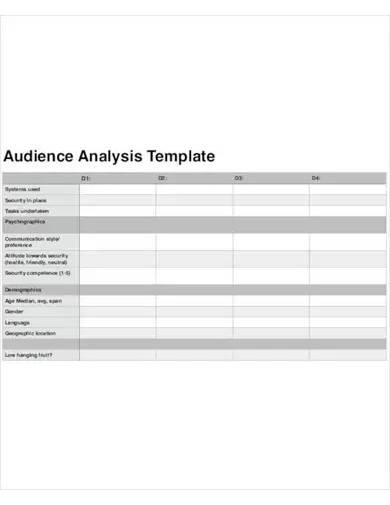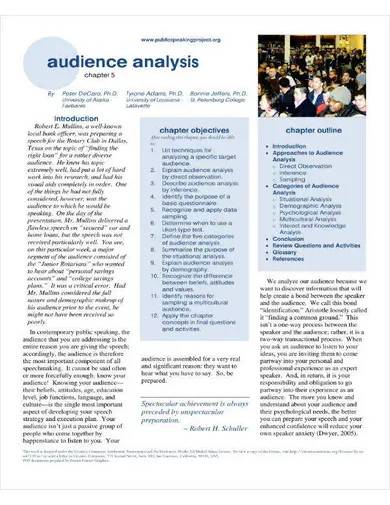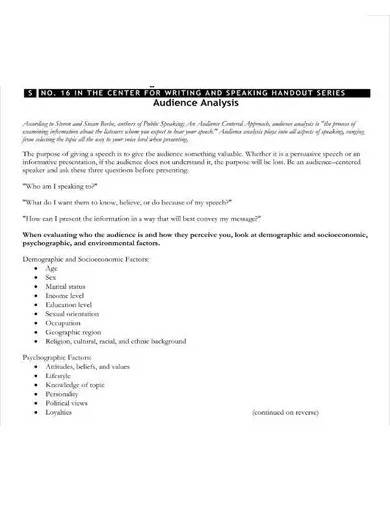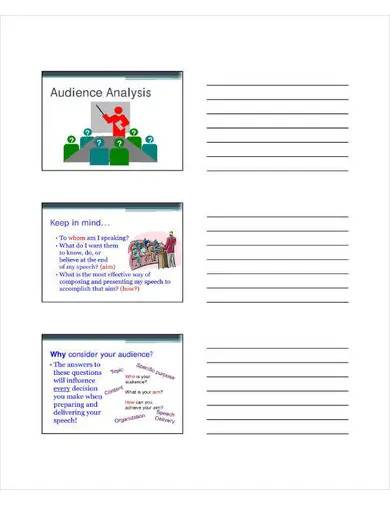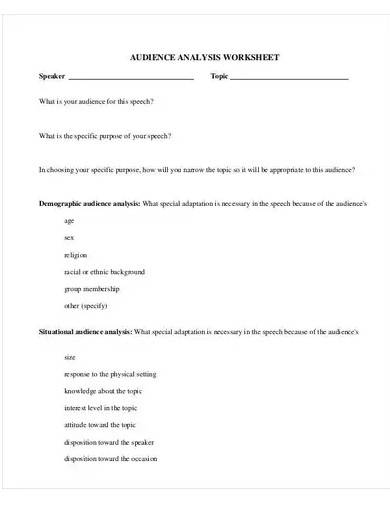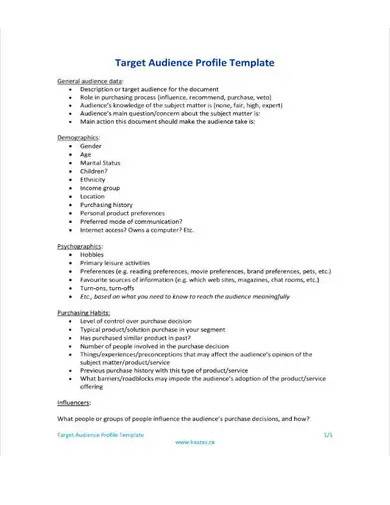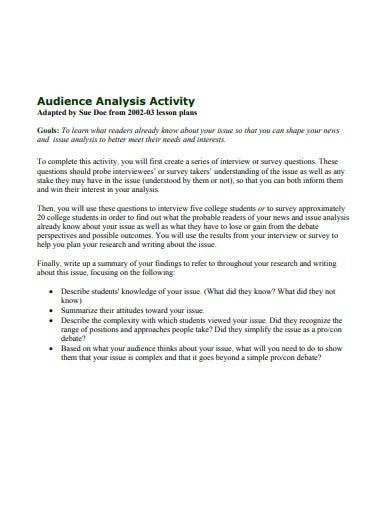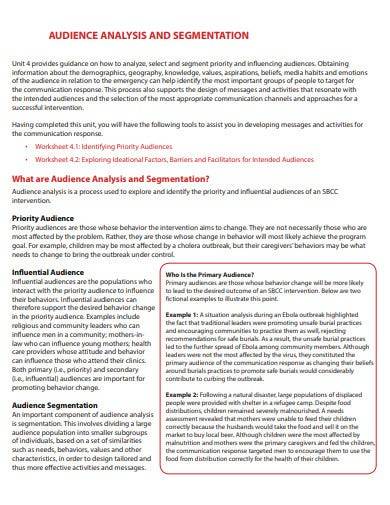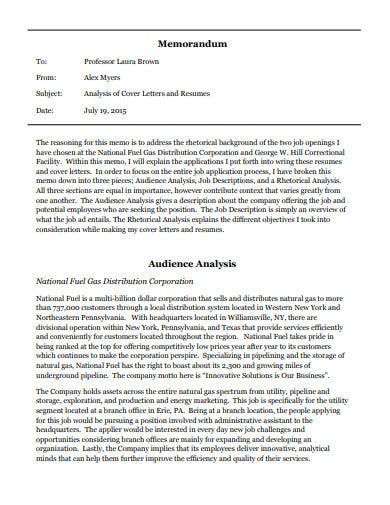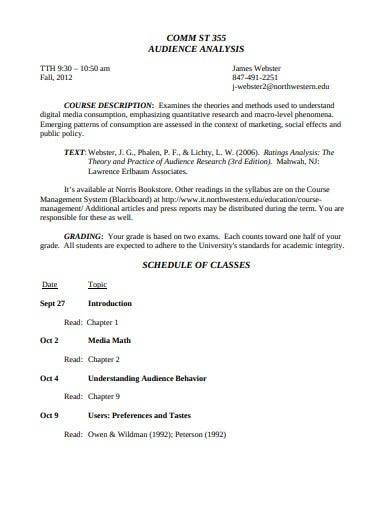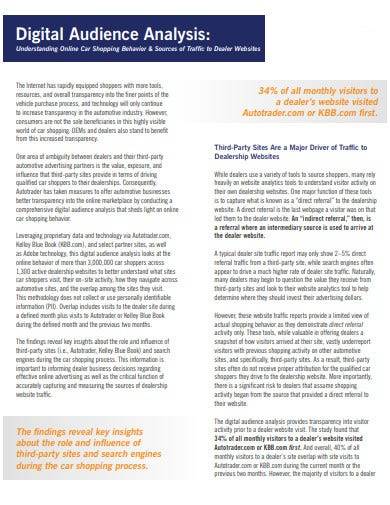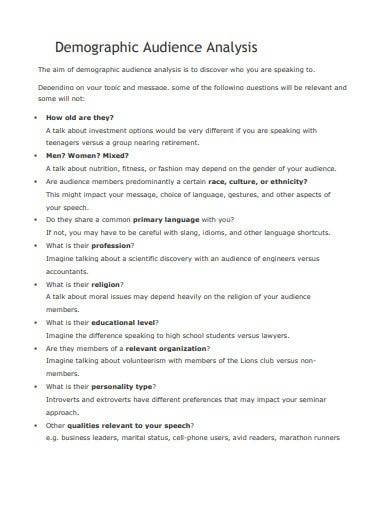Much of the world today, especially in various business sectors, aims to get a good grasp of their market’s choices and priorities to provide them with an idea of how to sell their ideas, goods, and services to them. This is nothing new in different industries, but nowadays, the market channels are increasing. There are numerous ways of how you can reach your audience, and each path requires different strategies. This is why audience analysis is important. This allows you to dig into your target market’s personalities, choices, and decision-making influences to appeal to their approval and preferences. Check out our collection and learn more from our article below.
15+ Audience Analysis Samples
1. Audience Analysis Template

2. Sample Audience Analysis Template
3. Professional Audience Analysis
4. Formal Audience Analysis
5. Sample Audience Analysis Guide
6. Printable Audience Analysis Template
7. Audience Analysis Worksheet
8. Target Audience Profile Template
9. Audience Analysis Evaluation Form
10. Sample Audience Analysis Activity
11. Audience Analysis and Segmentation
12. Simple Audience Analysis Template
13. Audience Analysis Memo Template
14. Basic Audience Analysis
15. Digital Audience Analysis Template
16. Demographic Audience Analysis
What Is an Audience Analysis?
An audience analysis is a process of identifying a group’s preferences, needs, and characteristics. This results in important findings that can help speakers, writers, content creators, and marketers understand their crowd and develop topics and strategies that effectively appeal to them. According to the Medium, the benefits of knowing your audience includes knowing how and where to spend your time and resources, increasing your competence in the field, and allowing you to create better promotional ideas and advertising plans.
Types of Audience Analysis
If you’re providing premium quality products, excellent services, unparalleled accommodation, or the most excellent content, why do you need to analyze your audience? This is because unless you’ve received your audience’s feedback, your claims of being the best will remain your personal opinion and assumption. You can’t be sure that your crowd or clients are pleased unless you have reliable research to back your statements. This is why you need an audience analysis to help you.
If you want to know more, here are the different audience analysis types to help you get acquainted with the topic:
1. Demographic Analysis. This type of analysis answers the different basic audience characteristics. This provides information on age, race, ethnicity, location, occupation, and status. A demographic provides facts straight from a person’s file. Demographic surveys are often used to classify the audience according to their similar qualities and determine which age group or gender shares the same interest.
2. Psychological Analysis. While the demographics provide direct details, a psychological analysis focuses on the audience’s opinions, preferences, and attitudes. This requires a more in-depth tool. This reveals your audience’s perspective about matters that are relevant to your objectives. Determining what lies on someone’s head gains you significant marketing leverage in presenting your ideas so that you know they would certainly find impressive.
3. Behavioral Analysis. This analysis aims to comprehend audience behavior and to understand how their experiences govern their choices. By identifying what affects them and how they change their decisions, you’ll identify opportunities to win their approval. This also provides you with insights on how to appeal to them better.
How to Make an Audience Analysis
Here are some tips on how to make an audience analysis:
1. Identify Your Target Audience
Your target audiences are those that will most likely prefer your products or services, consume your online content, or attend your speech. They are the ones you would expect to find among your crowd. While you may want to expand your reach and become more relatable across all age groups and various personalities or characteristics, you must first understand your immediate surroundings. After all, they’re your “target” audience in pursuing your market analysis. Identify who they are and why they’re significant to you. You don’t need to provide in-depth details to describe them. If you’re promoting toy products, you might expect to have an audience of young children, parents, or toy collectors. This information will be enough to get you started.
2. Determine The Answers You Need
Once you’ve identified your target audience, determine what information you want to know about them. Are you planning to learn about their dessert preferences for your menu? Do you want to inquire about their office needs? Are you hoping to find out about their cosmetic trends? Are you hoping to find out about their career aspirations? This provides your overall analysis process with a goal that consists of answers you want to hear. Along with this, you may also want to identify their demographics to help you identify their characteristics.
3. Come Up with an Analysis Tool and Technique
Now that you have a list of things that you want to know about your audience, you can now identify what method to use in obtaining your desired information. Before you do that, assess the information you need and find out the required elements in conducting your analysis. Will you need the answers straight from your audience, or do you want to observe their reaction to an influencer? Will you invite them for a test-taste? There are several things that you need to consider in making this happen. If you want to gather a majority of their opinion, you can conduct evaluations and surveys through questionnaires or checklists. You can also gather representatives and perform focus group discussions. Whatever method or tool you decide to employ in your data-gathering, make sure it provides you with the right answers.
4. Create your Audience Profile
From the results you’ve gathered from your analysis, compile your answers, and create your audience profile. This will culminate your analysis procedure because it will lay all the results and clarify your questions. This will serve as a valuable finding that you can use to make your market plan, content strategy, or to understand your audience’s needs better. This will provide you with insights into how to upgrade your operations to cater to their interests and preferences. With this knowledge, you’ll perform your tasks excellently and beat your competition in the field.
FAQs
What is an audience profile?
An audience profile contains not only an audience’s location, age, and nationality, but also deeper details such as attitudes, preferences, and audience trends.
What are the different types of target audience you’ll meet?
The different types of target audiences are classified based on locations, demographics, needs, subcultures, super cultures, personalities, and attitudes.
What are the different audience analysis factors in public speaking?
According to the University of Pittsburgh’s Department of Communication, the different audience analysis factors in public speaking are the audience’s attitude towards the subject, knowledge about the topic, expectation, demographics, population, environment, participation, and egocentrism.
Whether you’re an independent creator, running a startup business, or a stage presenter, you need to have the means to evaluate your audience’s perspective and preference in relation to what you’re offering in public. Conducting an audience analysis will be of great help to you. However, if you find the length of its document fussy to make, skip the hassle, and get yours from our audience analysis templates. Download now!
Related Posts
FREE 9+ Character Analysis Templates in MS Word | PDF
FREE 10+ Process Hazard Analysis Samples in PDF
FREE 10+ Value Chain Analysis Samples in MS Word | Google Docs | Apple Pages | PDF
FREE 10+ Turnover Ratio Analysis Samples and Templates in PDF
FREE 10+ Soar Analysis Samples in PDF
FREE 10+ Rhetorical Analysis Samples in PDF
FREE 10+ Analysis of Alternatives Samples in PDF
FREE 10+ Failure Mode and Effects Analysis Samples in PDF
FREE 10+ Make or Buy Analysis Samples in PDF
FREE 10+ Fishbone Root Cause Analysis Samples in PDF
FREE 11+ Cost Volume Profit Analysis Samples & Templates in PDF | MS Word
FREE 6+ Corporate Portfolio Analysis Samples in PDF
FREE 10+ Fault Tree Analysis Samples in PDF
FREE 10+ Comp Analysis Samples in PDF
FREE 10+ Fishbone Analysis Samples in PDF

